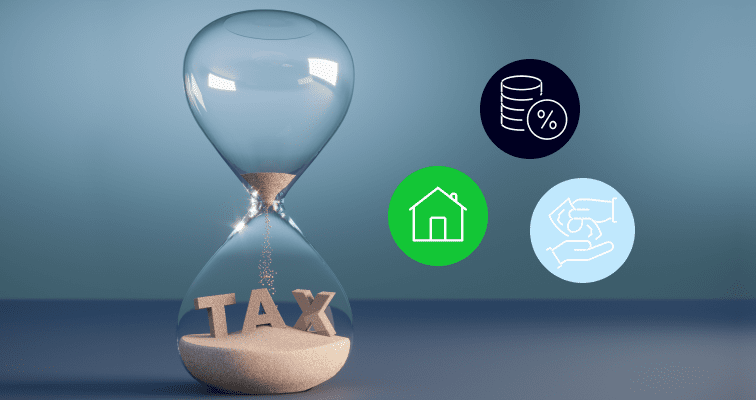When you sell assets, returns may be liable for capital gains tax (CGT). Find out what CGT is, how it works in France, and what it means to you as an investor.
The investing process has been revolutionised by online brokers that offer a user-friendly and cost-effective way of buying into capital markets. Selling assets, however, is not always so simple. In France, if you sell an asset at a higher price than that which you paid for it, you could be liable for capital gains tax (CGT).
This guide will make your investment journey easier, particularly when it comes to understanding CGT. It will explain what it is, when it applies, how to calculate it, and how to explore potential ways of reducing your tax burden.
What is capital gains tax (CGT)?

In France, buying financial instruments such as stocks, or capital assets such as property, may lead to a capital gain. In many instances, the French tax authority requires that you pay a levy, known as capital gains tax (CGT), on this gain.
The golden rule is that if you sell an asset at a higher price than that which you paid for it, you could be liable for CGT.
It is your obligation to understand how CGT works in France, as you may be liable for fines if you pay the incorrect amount of CGT or fail to pay it at all. The French tax authority website provides all of the information that investors require to help them understand and report on their capital gains liabilities.
Tip: Keeping accurate records of your trades will help you to navigate the CGT system, and identify opportunities to reclaim tax.
In France, the amount of capital gains tax that you are liable to pay will depend on a number of factors, including the type of assets involved, your personal income tax (PIT) marginal rate, and whether you have accumulated any capital losses within the same tax period that can offset your overall tax obligations.
One of the most important of those variables is the length of time that you hold your shares before selling. To encourage sensible investment, rather than short-term trading or speculation, the French tax authorities offer tax rebates on long-term investments.
Which assets have capital gains tax?
It is important to know which assets are subject to CGT. While not an exhaustive list, here is a breakdown of some popular assets that are liable for capital gains tax:
- Shares, bonds and similar investments
- Assurance Vies funds where premiums were paid after September 27, 2017
- Equity funds
- Dividend and interest income
- Royalties
- Foreign income
- Real estate (including part-built and unbuilt)
- Cryptoassets
- Collectibles (e.g., artwork, jewellery, antiques, yachts, wine) with sale value > €5,000
- Foreign currency
- Intangible assets (e.g., contractual rights, licences, leases)
Conversely, CGT-exempt assets in France may include:
- Cars
- Your principal home
- Household goods and furniture (excluding antiques and art)
- Gambling, lottery and betting prizes
Tip: Always do your own research before selling an asset to establish if you have to pay CGT.
For active investors who regularly trade CGT-liable assets, seeking help from an experienced tax agent could be beneficial to ensure that you do not neglect your CGT liabilities, or overlook opportunities to reduce your tax burden.
How does CGT impact my other investments?

CGT is an integral part of investing in France. The most direct impact on your portfolio will likely be that your returns will be lower than if CGT didn’t apply.
With applicable rates varying across asset types and depending on how long you hold an investment, CGT could also influence the decision on which assets you buy, and when to sell them.
Selling a CGT-liable asset activates a CGT event, marking the moment of sale when a capital gain or loss occurs. It is crucial to confirm proper processing by ensuring that your financial agent withholds the applicable tax from the distribution and submits the tax amount to the relevant tax authority. Correct any errors, typically through an end-of-year tax return.
Given the continuing popularity of the stock market, the most common CGT event is likely to be when you sell shares. However, as established, many more assets fall within the scope of French CGT, and prudent investing requires that trading activity be accurately recorded whether your investment generates a profit or a loss.
Although the French tax authorities have shifted to online filing for many documents (including tax declarations) and many are now digital, some records remain in paper form. Paper statements related to investments are often considered originals, with digital versions viewed as copies. It is, therefore, essential to retain all paper copies, despite the convenience of online reports.
As some documents may need to be presented up to 30 years after they were originally issued, most investors take the approach of holding onto paperwork forever. The Avis d’Imposition, for instance, must be retained for a minimum of six years. Failure to produce requested documents during an audit may result in fines of up to €5,000.
Subsequently, the recommended list of personal documentation to keep in paper form is extensive, including:
- Broker statements
- All documents relating to income tax, property taxes, business taxes and TVA (VAT)
- House deeds or property transfer documents
- Notaire fees
- Work and salary documents
- Bank statements and other banking documents
- Insurance certificates and details of insurance claims
- Rental contracts and receipts for utility bills
- Loan repayments
- Invoices and receipts relating to work carried out on your home or car
- Will and testament
- Birth, marriage and death certificates (including those of your parents)
- Diplomas, degrees or other qualifications
- Any important medical documents or medical history
For businesses, even those no longer trading, it’s advisable to keep hard copies of:
- Business accounts
- Invoices
- Orders
- Client details
- Employee contracts, salaries, pay slips, etc.
- Details of employee working hours should be kept for up to one year
How do I calculate my CGT?

French capital gains tax, although simplified by President Macron’s 2017 reforms, is relatively complex.
Capital gains derived from the sale of movable assets, such as securities, are subject to a default rate of 30% (12.8% income tax and 17.2% social levies).
High earners who pay “exceptional” income tax are subject to an additional four percentage points (34%).
CGT on immovable assets, such as property, is more complicated. It can be charged at variable rates depending on different conditions.
To self-calculate your CGT obligations, follow these four key stages:
- Calculate your base expenditure: The total consideration on the purchase of your investments minus any commissions or fees you paid.
- Calculate your realised amount: This is the consideration attributed to your account when you sold the asset, factoring in any fees or commissions you paid.
- Determine the difference: Subtract the net total revenue from the net total expenditure to establish if you have a capital gain or a capital loss.
- Establish your tax rate: If you are a low earner, it may be beneficial to opt to tax capital gains at the progressive income tax rates.
Tip: A tax professional can help you to navigate the French CGT landscape, and provide reassurance that you are operating correctly.
How can I minimise my CGT burden?
While you may not be able to avoid paying capital gains tax entirely, you may be able to apply strategies that minimise your annual CGT burden. Most of these strategies relate to legacy rights, and investments made before the 2017 tax reforms put though by President Macron.
Opt for taxation at the progressive personal income tax rates
Those who sit in lower income tax brackets and have held shares since before January 1, 2018 can receive a CGT rebate of 50% on holdings held for between two and eight years, or, 65% on positions held for eight years or more.
Hold shares in small companies for a long time
Those who have owned shares in small and medium-sized companies (PMEs) prior to January 1, 2018, can receive a CGT rebate of 50% on positions held for between one and four years, 65% on those held for four to eight years, and 85% if held for eight years or more.
Consult a professional
A tax agent experienced in overseeing the processing of investment returns can give you personalised advice on how to best reduce your CGT burden. They can help you to establish ways of minimising your tax obligations and ensuring that you don’t make errors in your filings.
Optimise capital losses
Not all trades post positive returns, and the gross amount of any year’s capital losses may be offset against taxable capital gains for the same year if holdings are of the same nature.
Final thoughts
Capital gains tax is a necessary part of being an investor in France and it can help you to optimise your returns if you devote some time to understanding your obligations. The flat-rate tax scheme introduced in 2017 has simplified the situation to some extent, but it is still important to consider factors that relate to your personal circumstances.
Ensure that you keep an accurate record of your filings and statements, especially paperwork originals. Engaging with a specialist tax advisor can also be a good idea, especially if it allows you to devote time to the business of getting your core investment decisions right.
Join eToro today and learn more about CGT, investing in the financial markets, and trading in general.
FAQs
- What is the best way to keep track of my transactions and statements?
-
The financial institutions that hold your investments should issue reports of your transactions and any CGT charges that are applied to your account. Store paperwork safely, and consider using an online service to review transactions and statements in a more user-friendly format.
- How can I determine if my assets are movable/immovable or intangible/tangible?
-
It is important to establish which of these categories your assets fall into as they are taxed very differently. Movable assets such as shares are more likely to have the standard 30% CGT rate applied to them, but CGT on immovable property assets is more complicated. If you’re unsure, it is recommended that you contact a specialist tax advisor for advice.
- Who makes the payment of CGT to the tax authority?
-
This depends on the type of asset in question. Taxes on property sales are, for example, calculated and processed by the notaire. Any capital gains made from stock dividends will be withheld by your broker or whichever institution manages your holdings. It is still your responsibility to check that the calculations and payments are correct, and, if required, complete a personal end-of-year tax return.
This information is for educational purposes only and should not be taken as investment advice, personal recommendation, or an offer of, or solicitation to, buy or sell any financial instruments.
This material has been prepared without regard to any particular investment objectives or financial situation and has not been prepared in accordance with the legal and regulatory requirements to promote independent research. Not all of the financial instruments and services referred to are offered by eToro and any references to past performance of a financial instrument, index, or a packaged investment product are not, and should not be taken as, a reliable indicator of future results.
eToro makes no representation and assumes no liability as to the accuracy or completeness of the content of this guide. Make sure you understand the risks involved in trading before committing any capital. Never risk more than you are prepared to lose.


